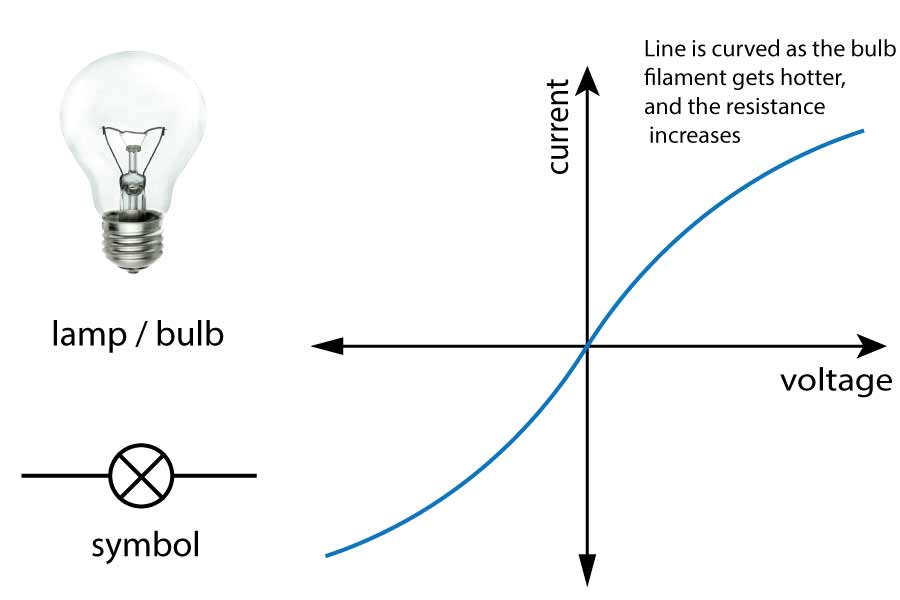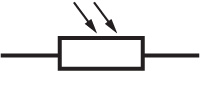Cambridge IGCSE
TOPIC 4A: ELECTRICITY
In this section we will take a closer look at some other common components in circuits, and learn a bit more about how they function.
Light bulbs used in laboratory circuits (correctly called filament lamps) have a very thin wire inside. This wire glows white hot when a current passes through it, producing heat and light.
Wires normally follow Ohm's Law - the current through it is proportional to the voltage applied. However the thin wire in a lamp gets so hot that the resistance increases. The current still increases with voltage, but - as you can see on the graph below in figure 1 - the line becomes curved. It no longer follows Ohm's Law.

Figure 1. I~V graph for lamps
Watch out for exam questions where the current and voltage axes have been reversed! The curve will then be reversed as well, have an increasing gradient in the top right section.
Sometimes the graphs shown in the exam have negative as well as positive axes as shown here. A negative voltage means that the power supply has been reversed so that current flows though the component in the opposite direction. For a resistor and a bulb, the graph shape is a direct mirror image as the direction of current has no effect on the behaviour of the component. This, however, is not true for diodes.
Diodes are very clever components that work like one way gates. Current can only go through one way. They work a bit like a standard door that opens one way only. (not a 'swing' door).
To open a door, you need a small push to get it open - then lots of people can 'flow' through the doorway. However if you push on the door from the other side, it will not open, and no one can go through.
Similarly for a diode, you need a small forward push (a voltage or p.d. across the diode) to get it to 'open' or conduct electricity. If the voltage is reversed, virtually no current flows - the resistance is extremely high.
The diode conducts in the direction of the arrow shown in the symbol, as shown below.
Light Emitting diodes (LEDs) are simply diodes that emit light when a current flows through it. Otherwise it behaves (almost) exactly like a normal diode. You can buy LEDs in many different colours, and as they are getting more and more efficient, they are becoming more common place and used widely for household and office lighting. They are also used in T.V. sets, traffic lights, power indicators and many more applications.
| Diode |  Current → |
 |
| LED (light emitting diode) |
 |
 |

Figure 2. I ~ V graph for diodes
You will need to learn to recognise and draw the graph above.
All LEDs are usually connected in series with a protection resistor - as you can see from the graph above, they only need a small voltage, and for most of them the maximum current is still quite low as they are so efficient.
A thermistor is a heat sensitive resistor. As the temperature of the surroundings increases, the resistance decreases.
An LDR is a light dependent resistor. As the light level increases, the resistance decreases.
For both of these devices, the resistance change is in reverse to the quantity being sensed, so for the thermistor, it has a higher resistance when the temperature is low. These sensors are very useful in circuits that are needed to detect changes in the environment - for example to turn on street lights at night, and to turn on the heating at home when it gets too cold.
| Thermistor |  |
temperature ↑ = resistance ↓ |
| LDR (light dependent resistor) |
 |
light level ↑ = resistance ↓ |
Both of these components can be included in simple circuits, and you will be asked to describe and explain what is happening. Have a go at these questions to check you understand the rules above:
Questions:
1. The following circuit is constructed with a fixed resistor, an LDR and various meters:

The light level in the room slowly increases. Explain what happens to the readings of:
This question is hard because it involves knowing about the components in detail, as well as understanding the rules for a series circuit from section 2.3.
a) As light falls on an LDR, the resistance decreases. This means the total resistance of the two components also decreases (The total is the sum of the two resistors - the ammeter can be ignored).
If the total resistance decreases, then the current increases as shown on the ammeter.
b) We know that for the fixed resistor, V = I x R
If the current I round the circuit increases, and R is fixed, then V1 must increase.
c) The voltage in a series circuit is shared between the components.
If V1 increases, then V2 must decrease - the LDR gets a smaller share of the voltage and has a smaller p.d. across it.
2. An LED is connected in series with a 6V cell and a thermistor.
a) The circuit diagram should look like this. Note that the L.E.D. arrow must be in the direction of current flow from positive to negative.

b) As the temperature increases, the resistance of the thermistor decreases. This means that the current will increase in the circuit, and the LED will become brighter.
(Remember that this is an 'explain' question, so you need to use physics to explain carefully what is happening, not just state the final outcome).
Here are a few other common components that you should be aware of, and be able to understand in a circuit diagram:-
| A power supply |  |
For example, a laboratory 12V power supply used instead of cells. Learn more about a.c. and d.c. power in section 4.4. |
| A heater (or heating element) |  |
As found in room heaters, hair dryers and toasters. |
| A motor |  |
As found in toy cars - uses electricity to turn the wheels. |
| A generator |  |
Generates electricity by spinning the generator, as found in wind turbines. |
| A loudspeaker |  |
Produces sound waves from electrical signals. |
| A buzzer | A standard buzzer or more modern 'peizo-sounder'. | |
| A fuse |  |
See section 4.4 on electrical safety for how these are used. |
| A relay coil | See section 4.5 on how relays can be used to switch high power circuits on/off. | |
| A transformer |  |
See section 4.5 on how transformers work in a circuit. |
| Variable Resistor |
|
A resistor that can be increased or decreased, as found in light dimmer switches or old-style radio volume controls. |
Now try this quick 10 minute quiz on components: